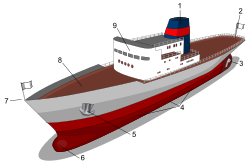
Main parts of ship. 1: Funnel; 2: Stern; 3: Propeller and Rudder; 4: Portside (the right side is known as starboard); 5: Anchor; 6: Bulbous bow; 7: Bow; 8: Deck; 9: Superstructure
In naval architecture, an afterdeck or after deck, or sometimes the aftdeck, aft deck or a-deck is the open deck area toward the stern or aft back part of a ship or boat. The afterdeck can be used for a number of different purposes, yet not all ships have an afterdeck. In place of the afterdeck, a ship may be built with a poop deck, that is a deck that forms the roof of a cabin built in the rear, or "aft", part of the superstructure of a ship; a poop deck is usually higher up than an afterdeck. A ship may have its superstructure or aftercastle located in the stern and thus not have an afterdeck. The stern and afterdeck of a ship are usually more smooth and stable than the bow (front) of the ship in motion. A taffrail is the handrail around the open afterdeck or poop deck. On wooden sailing ships like man-of-war or East Indiaman the taffrail is usually a hand carved wood rail and often highly decorated. [1] [2] [3] [4] [5]









